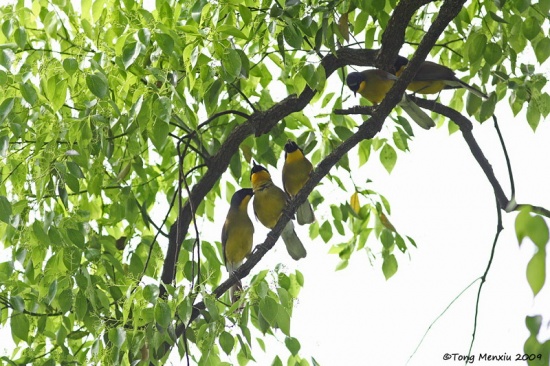- Pterorhinus courtoisi
Garrulax courtoisi
Identification
23 - 25cm. A rather small laughingthrush, superficially similar to Rufous-vented Laughingthrush:
- Black mask (including chin) and bill
- Blue crown
- Olive-brown above with grey crown
- Entirely yellow below
- Grey tail with broad blackish subterminal band and broad white outer tips
Sexes similar. Juveniles are warmer brown and have white upperparts with only little yellow
Similar species
Generally smaller and slimmer, with a shorter bill, paler crown and mantle than Rufous-vented Laughingthrush. Note also the different tail.
Distribution
Two isolated populations in China (Simao region in Yunnan and Wuyuan area in Jiangxi).
Critically endangered. May already be extinct in Simao region and population around Wuyuan estimated at 150 - 190 birds.
Taxonomy
Clements2 accepts two subspecies:
- P. g. cortoisi in NE Jiangxi (China)
- P. g. simaoensis in Yunnan (China) - validity of this subspecies is sometimes doubted
Was formerly considered conspecific with Yellow-throated Laughingthrush and is also placed in genus Dryonastes or Ianthocincla.
Habitat
Mixed evergreen and deciduous forest and also clumps of trees in human settlements.
Behaviour
Diet
Feeds on insects and small seeds.
Usually seen in pairs or small groups.
Breeding
Breeding season from April to July. They nest in cup-shaped nests of twigs and plant fibres. 2-4 eggs are laid and are incubated by both parents for 13 days.
Movements
Resident species. The Chinese population disappears after breeding, maybe doing short-distance movements.
References
- Del Hoyo, J, A Elliott, and D Christie, eds. 2007. Handbook of the Birds of the World. Volume 12: Picathartes to Tits and Chickadees. Barcelona: Lynx Edicions. ISBN 978-8496553422
- Clements, J. F., T. S. Schulenberg, M. J. Iliff, S. M. Billerman, T. A. Fredericks, B. L. Sullivan, and C. L. Wood. 2019. The eBird/Clements Checklist of Birds of the World: v2019. Downloaded from http://www.birds.cornell.edu/clementschecklist/download/
- Rasmussen, PC and JC Anderton. 2005. Birds of South Asia: The Ripley Guide. Barcelona: Lynx Edicions. ISBN 978-8487334672
Recommended Citation
- BirdForum Opus contributors. (2024) Blue-crowned Laughingthrush. In: BirdForum, the forum for wild birds and birding. Retrieved 29 April 2024 from https://www.birdforum.net/opus/Blue-crowned_Laughingthrush





